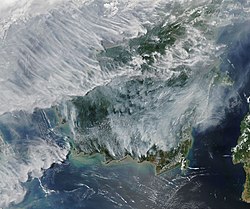This article needs additional citations for verification. (September 2012) |

| Southeast Asian haze series |
|---|
 |
| History |
| Key topics |
| Responses |
| See also |
|
|
The 1997 Southeast Asian haze was an international air pollution disaster that occurred during the second half of 1997, its after-effects causing widespread atmospheric visibility and health problems within Southeast Asia. Considered the most severe Southeast Asian haze event of all time,[1] the total costs of the 1997 haze are estimated at US$9 billion, due mainly to health care and disruption of air travel and business activities.
The influence of the 1997 fires in Kalimantan and Sumatra on ambient air quality was evident by July and peaked in September/October before weakening by November, when the delayed monsoonal rain extinguished the fires and improved air quality within the region. During the peak episode, satellite imagery (NASA/TOMS aerosol index maps) showed a haze layer that expanded over an area of more than 3,000,000 km2 (1,200,000 sq mi), covering large parts of Sumatra and Kalimantan. Its northward extension partially reached Malaysia, Singapore, Brunei, Thailand and the Philippines and its westward extension reached Sri Lanka.[2] During this period, particulate matter concentrations frequently exceeded national ambient air quality standards. Monthly mean horizontal visibility at most locations in Sumatra and Kalimantan in September was below 1 km (0.62 mi) and daily maximum visibility was frequently below 100 metres (330 ft).
- ^ Tacconi, Luca (July 2016). "Preventing fires and haze in Southeast Asia". Nature Climate Change. 6 (7): 640–643. Bibcode:2016NatCC...6..640T. doi:10.1038/nclimate3008. ISSN 1758-6798.
- ^ Jim, C.Y. (1999). Geography Vol. 84, No. 3 (The Forest Fires in Indonesia 1997-98: Possible Causes and Pervasive Consequences). Geographical Association. pp. 253–55.